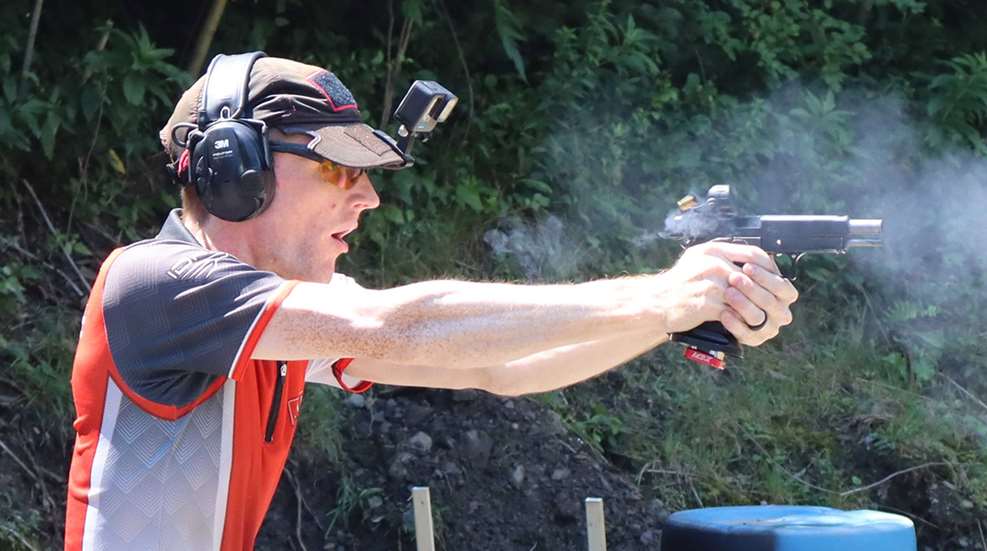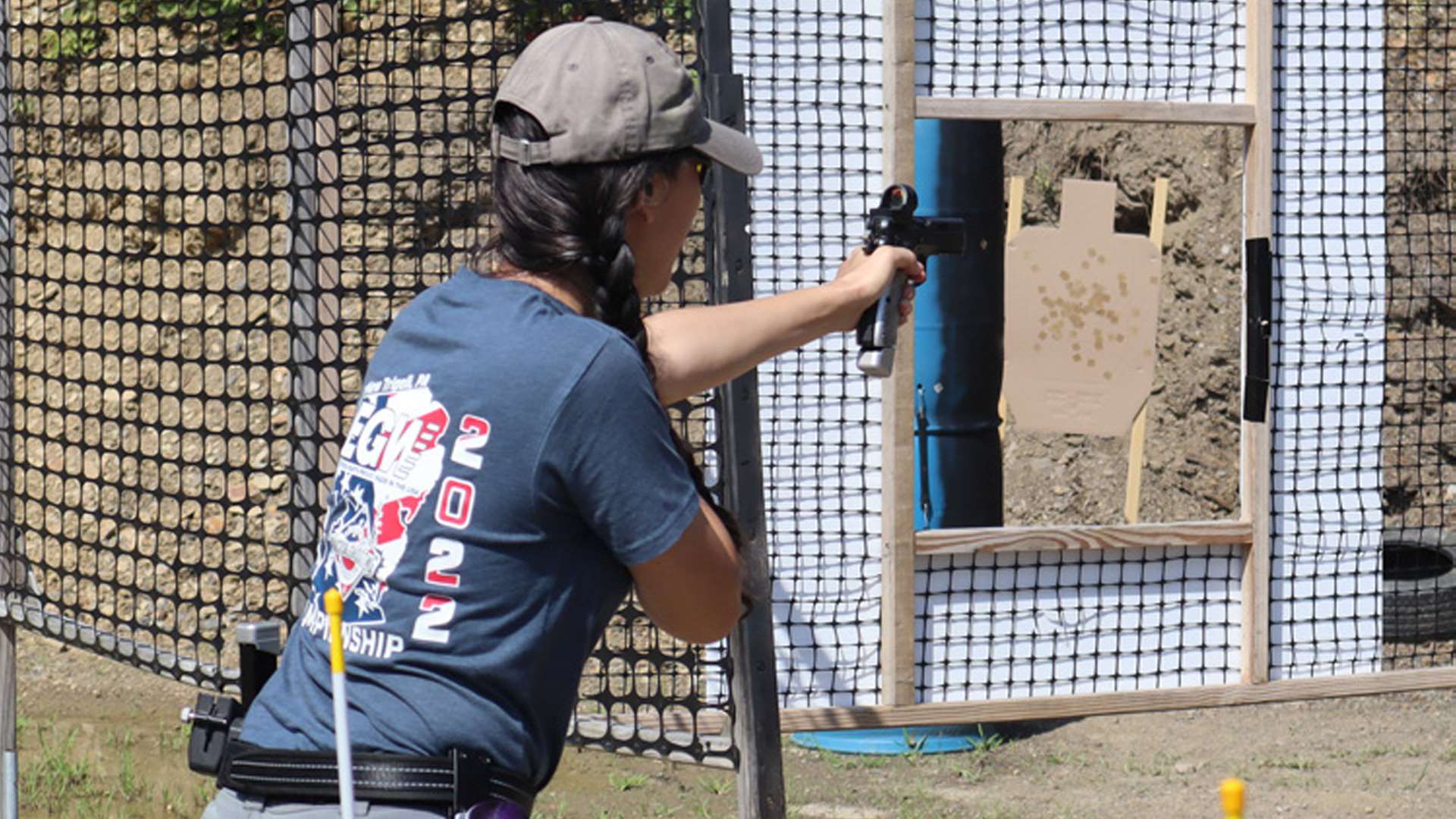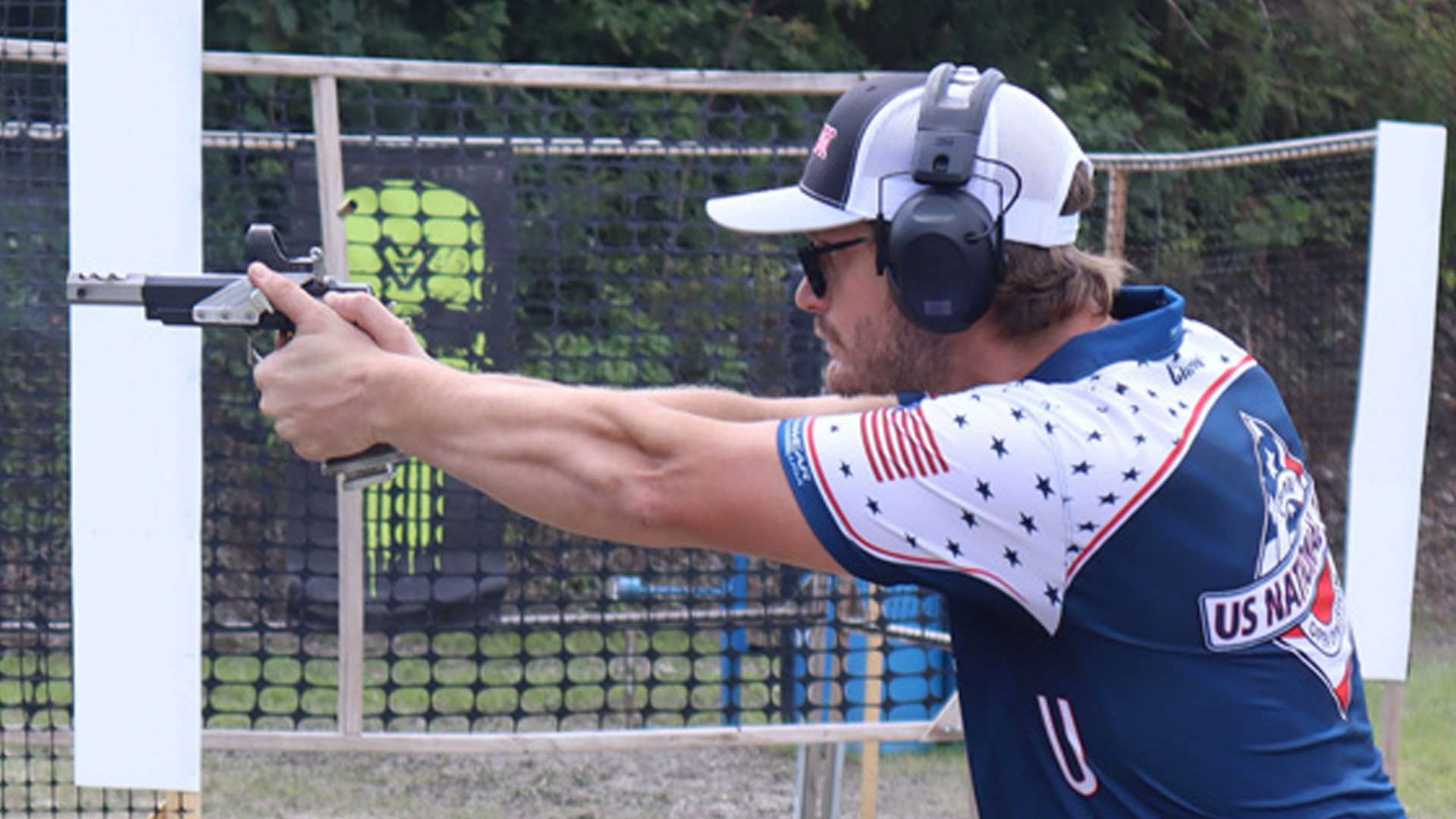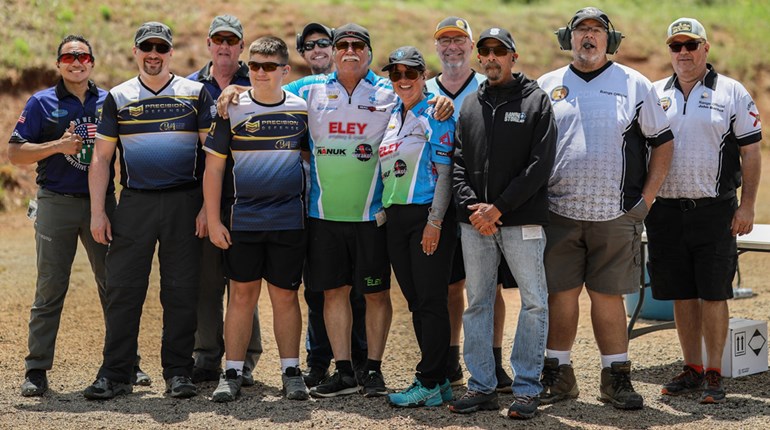
The 2023 Western Pennsylvania Section USPSA match, held at the Greater Pittsburgh Gun Club from July 28-30, was not only a challenging match that put the competitors’ skills and endurance to the test—it was also a memorable weather event that was an additional challenge in itself.
The match featured 203 shooters, with some traveling from as far as Canada to participate in the match. With the guidance of both Match Director David Dorisio and Range Master Russel Fortney, the match took place without a hitch. Among the participants were three distinguished medalists from the IPSC World Shoot—Chris Tilley, Bill Drummond and John Vlieger.
Mother Nature had other plans for staff on Friday and the shooters on Saturday. Staff shooting on Friday faced 96-degree temperatures with soupy humidity. As if the scorching heat wasn't enough, on Friday afternoon a thunderstorm struck the area, pelting the staff with heavy rain. But even after the storm passed and the sun came back out, the humidity remained and even intensified. It was the worst humidity I ever experienced.
Saturday morning the match was delayed a half-hour due to rain. The Saturday competitors faced the challenge of mud puddles and slippery bays. Luck was not on their side as the rain returned in the afternoon, hitting them with two more heavy downpours.

Despite the challenging weather conditions, Sunday proved to be the saving grace of the match. The temperatures were more seasonable; there were were still some mud puddles to deal with, but Sunday was by far the best day to shoot.
The stages themselves were both fun and challenging this year, compared to last year’s match which was more technical. There were many surprises, compliments of Ron Kiesel, the owner of Sigma Arcworks, who designed some particularly tricky, yet fun props, that left competitors strategizing their approaches. As the stage designer for the match, it was an honor to incorporate Ron's props into my stages.
Stage 1, “Limbo Showdown” was a 26-round stage that I particularly enjoyed because it was a lot of fun to shoot. The stage featured 12 USPSA targets and two mini-poppers. The shooter was free to start anywhere in the shooting area. I found that starting the stage from the left-hand side allowed all the targets to open up perfectly on the right. On the other hand, many shooters who began on the right side had to deal with extra steps and movements to get into position for their shots.
The grand finale of the stage was the low port, which proved to be a hindrance for some of the competitors. It consisted of two mini-poppers and two targets arranged in a fan shape, with a no-shoot target in the middle. Open shooter Chris Tilley won this stage with an impressive time of 14.64 seconds with 123 points out of 130. John Vlieger was the runner-up, shooting the stage in 15.78 seconds, with Matthew Hemple following in third place with a 17.55-second run.
Stage 2, “Swaying Bullseyes” consisted of 12 IPSC targets and one mini-popper. The starting position for this stage was on a wall in the middle of the stage. The competitor had to back up to engage the targets on the left. As the competitor moved backward, the highlight of this stage became evident, with two swinging targets coming into full view. These double swingers were not synchronized and could only be engaged from the back. Most shooters activated the popper as soon as it came into sight, engaged the targets on the left, then turned to engage the double swingers. Even though the swingers were activated, this approach didn't provide enough time for the targets to lose momentum, so the shooter had to be both quick and accurate.
After engaging the double swingers, the competitor turned to the right and continued to the front, engaging the remaining targets. Chris Tilley was the winner of Stage 2 with a time of 14.84 seconds and 121 points. Bill Drummond secured the second position with a time of 15.80 seconds, while third place went to John Vlieger with a 14.78-second time.

Stage 3, “Russell’s Perrier” was a design that came to mind while I was driving in the car. Pretty scary, huh? After the matchbook was printed, my husband and Match Director Dave Dorisio decided to flip the stage around because he didn’t like the fact that it had a similar start position as Stage 5.
The course of fire started on the left side of the stage and consisted of 16 IPSC targets with 32 rounds. Upon the start signal, the competitor engaged two targets, one to the far right and one to the left. As the competitor proceeded toward the front of the stage, two targets were hidden between two V-shaped walls, and this was the beginning of the memory stage. It was a fairly easy memory stage, yet some competitors hesitated and missed a target and had to back up, losing valuable time. The targets were mostly wide open, but there were a few with no-shoots, and I observed several of the accomplished competitors falling victim to hitting them.
The stage winner here was Patches Reeder with a time of 16.02 seconds and 152 points. Bill Drummond came close behind in second place with a time of 15.71 seconds. Third place went to Chris Gelnett with a time of 16.21 seconds.
Stage 4, “Bill’s Zigzag Zaniness” proved to be a dreaded stage for some and a fun stage for others. Designed by Bill Drummond, it was based on a stage he shot at the World Shoot. The setup consisted of a 30-round stage with 14 IPSC targets, and it began with an unloaded start, with the firearm on a barrel. Imagine spider legs; competitors had to maneuver down both sides of these “legs” to reach the targets at their ends. Success in this stage heavily relied on speed, with the fastest runners having the best chance of scoring well. A 30-second run was considered fast. As a Pistol-Caliber Carbine shooter, the narrow walls made maneuvering difficult, and I was especially cautious not to break the 180, fearing disqualification. Surprisingly, there was only one disqualification on this stage.
Multiple approaches were possible for running the stage, but due to the heat and breathlessness from asthma, I chose not to sprint to the left like my squad mates. Instead, I started on the right-hand side and worked my way around to the front. At the front of the stage, there was a Cooper tunnel with two pieces of steel and two swinging targets. Engaging the swingers required leaning to the left and right through the tunnel. After dealing with the swingers, I followed the spider legs to the left. Being a left-handed shooter, it was relatively easy to back up on the left-hand side.
The stage winner turned out to be the designer himself, Bill Drummond, with a time of 30.66 seconds and 141 points. Chris Tilley secured second place with a time of 32.69 seconds, while Matthew Hemple claimed third place with a time of 34.65 seconds.
Stage 5, “Run and Gun Mayhem” featured a 28-round count and included two mini-poppers. The stage commenced with a sprint to the right, where competitors engaged two poppers, and then returned to the left to engage targets on the right engaging targets while moving towards the front of the stage. At the front of the stage, the competitors encountered Ron Kiesel's prop, a double target with a no-shoot sliding down a steel coaster. This prop was similar to the one used last year, but better designed. The competitor was given the choice of shooting the sliding targets or waiting until the targets stopped behind cover before engaging head shots. Chris Tilley was the winner of this stage, completing it in 17.15 seconds and 135 points. John Vlieger secured the secondplace position with a time of 17.35 seconds, while Bill Drummond took third place with a time of 17.93 seconds.
Stage 6, “Mobile Marksmen” was a 27-round course of fire with 12 IPSC targets and three mini-poppers. This stage featured Ron Keisel’s sliding swinger. The competitor had the option of starting anywhere outside the shooting area, working their way to the front of the stage and shooting targets along the way. On right side at the front of the stage, the competitors engaged a swinger, then took a quick run to the left where they faced the dreaded sliding swinging IPSC target. It actually wasn’t too bad to shoot; if you concentrated on the wide-open target and ignored the fact that it was sliding and swinging swiftly down the track, it wasn’t a bad shot. The winner of this stage was Chris Tilley with a time of 18.63 seconds and 125 points out of 135 points. Bill Drummond followed in second place with a time of 19.57 seconds, and third place went to Patches Reeder with a time of 21.39 seconds.
Stage 7, “Aim and Conquer” comprised a 12-round, 60-point Virginia count stage, featuring two strings—strong hand and weak hand—with one round for each string. I was trying to come up with a different type of speed shoot and this stage popped into my head. Despite the targets being wide open, a surprising number of competitors had misses.
Starting from outside the shooting area, participants faced an inverted T-shape configuration, with a wall directly ahead. They were given the option to move a few feet either to the left or right, choosing the direction that felt most comfortable for executing strong-hand shots. Once in position, a target stood directly in front of the competitor, accompanied by two targets that could only be engaged through ports—one port positioned on each wall. Upon successfully engaging these targets, competitors swiftly maneuvered to the opposing side, engaging targets in a mirror image.
The second string started in the same manner, the only difference being that they shot with their weak hand. Winning this stage was Pistol-Caliber Carbine shooter Aaron Sellers, boasting an impressive time of 14.62 seconds and securing 58 out of 60 points. Second place was earned by John Vlieger, completing the stage in 15.47 seconds, while Thrax Cui clinched third place with a time of 16.60 seconds, achieving a perfect score of 60 points.
Stage 8, “Accuracy Assault” lived up to its name. It was a spur-of-the-moment addition replacing a stage that was not working in the bay shared with Stage 7. This stage was comprised of 12 rounds and worth 60 points, with the competitors starting on the array of their choice. The stage featured five IPSC targets and two mini-poppers with two arrays, separated by barrels, which required a mandatory reload between arrays. On the right side there were three open targets, which posed a challenge for left-handed shooters due to the lean required to engage the leftmost target without hitting the barrel.
Upon completing this array and reloading, competitors leaned to the left to engage two mini-poppers. One of these targets activated a double-swinger, with a no-shoot target sandwiched between. Although the swinger wasn't particularly fast, it still instilled fear among the competitors. Interestingly, rather than engaging both double targets, some competitors opted to engage a target that was partially visible. Despite the swinger's slow movement, many competitors smacked the no-shoot target on the double-swinger.
Chris Tilley secured the stage victory, clocking in at 5.44 seconds and earning 55 out of the 60 available points. Bill Drummond claimed second place with a time of 5.84 seconds, while James McGinty, a single-stack shooter, secured third place with a time of 6.35 seconds.
Stage 9, “Low and Fast” was a 22-round course comprising of 10 USPSA targets and two mini-poppers. The setup of this stage included elements such as a swinger, an out-and-back and a max trap. The swinger was activated by opening the door, while a popper inside the door triggered the activation of the max trap. There was also a low port which required the shooter to engage a popper that set off an out-and-back target.
Chris Tilley won this stage, completing it in 12.28 seconds and accumulating a total of 103 points. In second place was Bill Drummond, who finished in 13.64 seconds, followed by Ryan Snyder in third place with a time of 14.65 seconds.
Stage 10, “Bill's Black and Gold” featured a 24-round Comstock course of fire that utilized a Ron Kiesel prop. The prop resembled a roller coaster, where three steel plates traversed a half-circle track in an up-and-down motion. Competitors started the stage outside the shooting area and entered from the right side.
Upon entry, competitors engaged a target positioned to the right before dashing to the left to engage multiple targets. Continuing around the walls to the right, two targets were strategically placed behind a barrel to the left with Ron’s roller coaster prop. There were two poppers on opposite sides of the prop and several scattered targets. The roller coaster prop was fast during the initial descent, and though it somewhat lost momentum as it reversed its direction on the track, it maintained a reasonable speed.
With time being a factor, competitors were smart to engage the steel plates on the roller coaster prop at first sight instead of waiting for it to slow down. After successfully engaging the moving plates, competitors ran to the right around a wall to engage a popper and two USPSA targets. The stage winner was Chris Tilley, who completed the course in a remarkable 13.72 seconds with 119 points. Securing second place was Chris Sendelsky, with a time of 13.84 seconds, while Wesley Cronin claimed third place with a time of 13.89 seconds.
Stage 11, “Battlefield Blitz” was a favorite among many of the competitors. It consisted of 26 rounds, featuring 11 USPSA targets and four mini-poppers. This stage challenged participants with a combination of close targets that could be blasted and distant targets that posed a significant shooting challenge. The stage winner, John Vlieger, completed it in 18.25 seconds. Taking second place was Chris Gelnett, who finished with a time of 17.70 seconds, followed by Bill Drummond in third with a time of 19.65 seconds.
In short, the Greater Pittsburgh Gun Club organized an impressive event. Despite tough weather conditions, the match truly tested participants' skills and endurance. Sigma Arcworks' Ron Kiesel enhanced the stages with his creative props.
Looking ahead, the Greater Pittsburgh Gun Club is determined to maintain its commitment to excellence and is getting ready to host the USPSA Area 8 match in June 2024. There's excitement surrounding Ron's upcoming work on three new challenging prop designs, which promise to enhance the experience even more. If you're interested in the thrill of a World Shoot-style setting, we welcome you to join us for the USPSA Area 8 match in 2024.
You can view the full results of the 2023 Western Pennsylvania USPSA Section Match at the Practiscore website.
Article from the November/December 2023 issue of USPSA’s magazine.


































